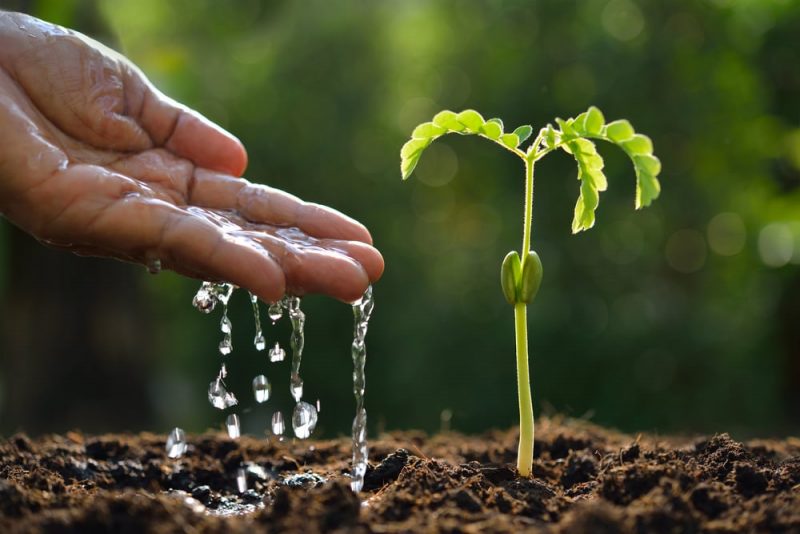An ecosystem is made up of two components that interact with each other: the living or biotic part formed by the various groups of organisms; and the physical or abiotic part that constitutes the environment where organisms live and develop.
In an ecosystem we find:
- Biotic factors. They are organisms, that is, all living things: from bacteria to the largest animals and plants. They can be heterotrophs (they take their food from other living beings) or autotrophs (they generate their food from inorganic substances). They are related to each other by predation, competition, parasitism, commensalism, cooperation or mutualism. For instance: bamboo, caterpillar, flies.
- Abiotic factors. They are all the factors that constitute the physicochemical characteristics of an ecosystem. These factors are in constant relationship with biotic factors since they allow their survival and growth. For instance: water, air, light.
Abiotic factors may be beneficial for some species and not for others. For example, an acid pH (abiotic factor) is not favorable for the survival and reproduction of bacteria (biotic factor) but it is favorable for fungi (biotic factor).
In a given ecosystem, biotic factors continually establish and modify the conditions in which organisms can live. For this reason, some organisms develop adaptations to these conditions, that is, living beings can be evolutionarily modified by biotic factors.
On the other hand, biotic factors also modify abiotic factors. For example: the presence of certain organisms (biotic factor) in the soil can change the acidity (abiotic factor) of the soil.
Examples of abiotic factors

- Water. The availability of water is one of the main factors that affects the presence of organisms in an ecosystem since it is essential for the survival of all forms of life. In places where there is no constant availability of water, organisms have developed adaptations that allow them to spend more time without contact with water. In addition, the presence of water affects the temperature and humidity of the air.
- Infrared light. It is a type of electromagnetic radiation, invisible to the human eye.
- Ultraviolet radiation. It is a type of electromagnetic radiation, which is not visible. The earth’s surface is protected from most of these rays by the atmosphere. However, UV-A rays (wavelength between 380 to 315 nm) reach the surface. These rays penetrate the inner layers of the skin, damaging the connective tissue that is under the epidermis, and this causes premature aging (which results in wrinkles). In contrast, UV-B rays (wavelength 315-280 nm) tan the skin and cause sunburn. Both types of UV rays can cause permanent DNA damage in skin cells, and produce mutations that lead to skin cancer.
- Atmosphere. The atmosphere and its characteristics affect the development of organisms.
- Temperature. For all organisms there is a maximum and minimum environmental temperature in which they can survive. For this reason, global temperature changes have as a consequence the extinction of various species. Microorganisms (called Extremophiles) can tolerate extreme temperatures.
- Air. Air content affects the development and health of organisms. For example, carbon monoxide in the air is harmful to humans. The wind also affects, for example, the growth of plants: trees that live in areas that have frequent winds in the same direction grow crooked.
- Visible light. It is essential for plant life as it is involved in the photosynthesis process. It allows animals to see around them for various activities, such as foraging for food or protecting themselves.
- Calcium. It is an element that is found in the earth’s crust but also in sea water. It is an important element for biotic factors: it allows the normal development of leaves, roots and fruits in plants, and in animals it is essential for the strength of bones, among other functions.
- Copper. It is one of the few metals that can be found in nature in its pure state. It is absorbed as a cation. In plants, it participates in the photosynthesis process. In animals, it is found in red blood cells, it participates in the maintenance of blood vessels, nerves, immune system and bones.
- Nitrogen. It forms 78% of the air. Legumes form symbiosis in their roots with bacteria that absorb it directly from the air. Bacteria convert it to nitrate. Nitrate is used by various organisms to synthesize proteins.
- Oxygen. It is the most abundant chemical element by mass in the biosphere, that is, the sea, the air and the soil. It is an abiotic factor but it is released by a biotic factor: plants and algae, thanks to the photosynthesis process. Aerobic organisms are those that need oxygen to convert nutrients into energy. Humans, for example, are aerobic organisms.
- Altitude. Geographically, the altitude of a place is measured taking into account its vertical distance from sea level. For this reason, when indicating the altitude, for example, 200 masl (meters above sea level) is indicated. Altitude affects both temperature (decreases 0.65 degrees for every 100 meters of altitude) and atmospheric pressure.
References:
- Biology: Solomon E., Berg L., Martin D. (2013) 9th Edition. Publishing Cengage Learning.
- Ecology I: Introduction. Organisms and populations. Scholastic León C., Cabildo Miranda M. del P., Claramunt Vallespí RM, Claramunt Vallespí T. (2013) Digital edition. National University of Distance Education.
